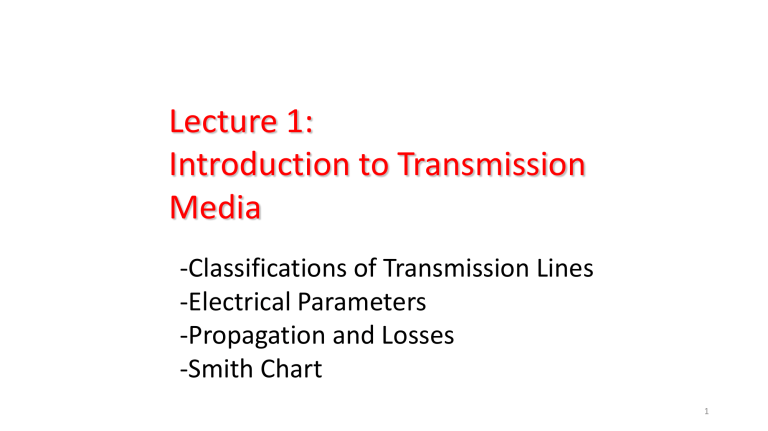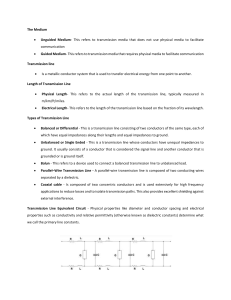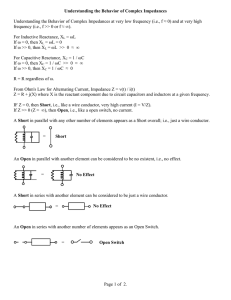
Lecture 1: Introduction to Transmission Media -Classifications of Transmission Lines -Electrical Parameters -Propagation and Losses -Smith Chart 1 Transmission Media A Transmission Medium is a material substance that can propagate energy waves Transmission Media can be categorized as: 2 Transmission Line A Transmission Line is a metallic conductor system that is used to guide or transfer electrical energy from one point to another Coaxial cable (coax) Twin lead 3 Transmission Line CAT 5 cable (twisted pair) The two wires of the transmission line are twisted to reduce interference and radiation from discontinuities. 4 Electromagnetic Waves Two basic kinds of waves: 1. Longitudinal Waves 2. Transverse Waves 5 Longitudinal waves • Longitudinal waves have vibrations moving in the same direction that the wave is travelling in • Examples of longitudinal waves are: Sound waves Shock waves Transverse waves • Most waves are transverse • The energy is travelling in one direction, with the vibrations moving at a 90o angle to the direction the wave is travelling Categories of Transmission Lines 1. BalancedTransmission Lines - Impedance to ground from each of the two wires is equal and this ensures that the current in both wires are equal in magnitudes but opposite in sign or travel in opposite directions Example: Twin – lead , twisted pair Categories of Transmission Lines 2. Unbalanced Transmission Lines - One wire is at ground potential, while the other is at signal potential Example: Coaxial Cable Categories of Transmission Lines Balun - An electrical device used to connect a balanced transmission line to an unbalanced load *Most common type of balun is a narrowband balun Parallel – Conductor Transmission Lines Parallel – wire transmission lines are comprised of two or more metallic conductors (usually copper) separated by a nonconductive insulating material (dielectric) Parallel – Conductor Transmission Lines Open – wire transmission lines -are two – wire parallel conductors -consist simply of two parallel wires, closely spaced and separated by air Parallel – Conductor Transmission Lines Twin Lead (Two – Wire Ribbon) -commonly used to connect a television receiving antenna to a home television set Parallel – Conductor Transmission Lines Twisted - Pair -the line consists of two insulated wires twisted together to form a flexible line without the use of spacers Coaxial Transmission Lines Coaxial -has an inner conductor surrounded by an insulating layer(dielectric material), then surrounded by a conducting shield and a rubber protection outer jacket Transmission Line Losses Copper Losses: Example: I2 R loss Whenever current flows through one of these conductors, some energy is dissipated in the form of heat (Power Loss) Dielectric Losses: Result from the heating effect on the dielectric material between the conductors 16 Transmission Line Losses Radiation and Induction Losses Radiation and Induction losses are similar. It is caused by the fields surrounding the conductors. Coupling Loss: Occurs whenever a connection is made to or from a transmission line or when two separate pieces of transmission lines are connected together. 17 Transmission Line Equivalent Circuit R L + Z0 G C ... - z 4 per-unit-length parameters: C = capacitance/length [F/m] L = inductance/length [H/m] R = resistance/length [/m] G = conductance/length [ /m or S/m] 18 Transmission Line: Primary Line Constants 2 conductors 4 per-unit-length parameters: C = capacitance/length [F/m] L = inductance/length [H/m] R = resistance/length [/m] G = conductance/length [ /m or S/m] 19 Transmission Line: Primary Line Constants where: = Permeability of medium in H/m = Permittivity of medium in F/m S = center to center spacing between conductors in m d = diameter of conductor in m For Coaxial Line D = Diameter of outer conductor in m d = diameter of inner conductor in m 20 Transmission Line: Primary Line Constants Example: 1. What is the capacitance of 55 miles #44 copper wire spaced 18inches ? From wire tables, #44 wire has a radius to 0.10215 ? 21 Transmission Line: Secondary Line Constants Characteristic Impedance ( Z0 ) Impedance seen looking at an infinitely long transmission lines or the impedance seen into a finite length of line that is terminated in a purely resistive load equal to the characteristic impedance of the line In terms of Primary Line Constant: 22 Transmission Line: Secondary Line Constants In terms of Physical Dimensions: 23 Transmission Line: Secondary Line Constants Example: 1. The primary line constant for a coaxial cable at a frequency of 10MHz were determine approximately as follows: L = 234nH/m, C = 93.5pF/m, R = 0.568/m, G = 0. Determine the characteristic impedance. Example: 2. A two – wire transmission line consists of N0. 12 wire AWG (81 mils). The distance between wire centers is 10 inches. What is the characteristic impedance of the line ? 24 Transmission Line: Secondary Line Constants Example: 3. A coaxial line with an outer diameter of 6mm has a 50 ohms characteristic impedance. If the dielectric constant of the insulation is 1.60, calculate the inner diameter. 25 Transmission Line: Propagation Constant () Propagation Constant -a.k.a “Propagation Coefficient” - use to determine the reduction in voltage or current with distance as a TEM propagates down a transmission lines In terms of Series Impedance(Z) & Shunt Admittance(Y): ZY 2 In terms of Attenuation Coefficient() & Phase Shift Constant(): j 26 Transmission Line: Attenuation Coefficient () & Phase Shift Coefficient Attenuation Coefficient () Phase Shift Coefficient () 27 Transmission Line: Attenuation Coefficient () & Phase Shift Coefficient Example: 1. A signal will undergo a phase shift of how many rad/m when propagating on a 25-m coaxial cable with a velocity of 0.66c and operating at 5MHz. Example: 2. The primary line constant for a coaxial cable at a frequency of 10MHz were determine approximately as; L = 234nH/m, C = 93.5pF/m, R = 0.568/m, G = 0. Calculate the attenuation coefficient in dB/m. 28 The END… 29


